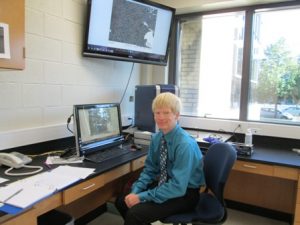Spin-dependent cyclotron total widths in strong magnetic fields
Research Advisor: Dr. Peter Gonthier
We are developing compact, analytical expressions of the cyclotron total spin-dependent widths, or lifetimes, of excited Landau states. These widths are required in our recent Compton scattering developments for strong-field magnetar magnetospheres. We begin with the analytics for the spin-dependent widths presented in Sina (1996), which has been our source for the development of Compton scattering, and establish equivalency with the differential widths developed by Latal (1986). Both approaches implement correct Sokolov & Ternov wave functions. From here, we make further improvements to develop an integral for the total differential widths with the integration variable only present in the square of the associated Laguerre functions. With the use of several series representations, we obtain an integral in the form previously used in our efforts. The result is an expression that includes Legendre functions of the second kind with an argument >1, for which we seek an algorithm for efficient evaluation. Exploring two possibilities, recursion relations, and hypergeometric functions, we find that the former breaks down for large values of the magnetic field (B) and the initial Landau state (n) due to the argument being >1. Taking the hypergeometric approach, we achieved numerical values that agree with Latal (1986) and Sina (1996) results for small n and B, but the analytics break down for large n and B. This problem encourages the development of asymptotic approaches similar to those developed in the past but for spin-averaged widths. These processes will be applied to future work.
This work is made possible by the generous support of the National Science Foundation (Grant No. AST-1009731), the NASA Astrophysics Theory and Fundamental Program (NNX13AO12G / 12-ATP12-0169), the American Physical Society, and the Michigan Space Grant Consortium.




